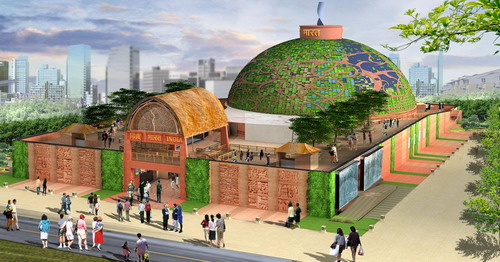Shanghai Expo 2010: The Indian Pavilion

The 2010 World Exposition in Shanghai will be the first registered one in a developing country. Officially known as “Expo Shanghai 2010,” it will last 184 days and provide China an opportunity to show off its remarkable economic growth. The expo will also give foreign nations and companies a chance to further develop business partnerships with China and Chinese companies. This is the fifteenth in an ongoing series that will look at the upcoming expo, from country pavilions to trade development. In this article, we take a look at the Indian Pavilion.
By Joe Drury
Apr. 30 – Since Winston Churchill’s 1931 speech that so famously described India as a “geographical term” and “no more a united nation than the equator,” the country has made vast strides and sacrifices to become an economically thriving and unified political state. Yet in terms of its almost overwhelming diversity, Churchill’s meaning is not completely lost.
India is home to over 2,000 ethnic groups, speaking over 1,600 languages and dialects and worshiping every major religion. At the 2010 World Expo in Shanghai, India’s 4,000 square meter pavilion stands as a monument to its ability to forge a sense of harmony and national unity from this disparate society despite the contradictions and sometimes violent differences that naturally arise in such an environment.
With the theme “Cities of Harmony,” the pavilion by extension also projects an international message of global unity, especially relevant to India as the country experiences the natural growing pains of greater influence in Asia and abroad.
“The India pavilion at Expo 2010 will project diversity and duality,” said Commissioner General N.K. Sehgal in a March 22 interview with China Daily. “India is a country with diverse geography, traditions, culture and languages. In both its cities and rural areas there is a unique duality of the ancient and modern.”
The building’s exterior proudly displays the ancient aspects of Indian society by paying tribute to works of Indian culture and art. The arched entranceway features a replica of the intricate tree of life stone carving from the Sidi Saiyed Mosque of Ahmedabad, while terracotta walls inside exhibit scenes from the Buddhist Jataka Tales espousing the interdependence of man and nature.
Hidden behind its facade of an ancient temple are the tools of a technologically advanced sustainable future. The pavilion is designed to be a “zero-chemicals zone,” meaning it produces safe runoff containing no effluents. A network of cooling pipes embedded in the floor will maintain a comfortable temperature in the hot summer, and roof-mounted solar cells and wind mills constantly generate renewable energy, breathing fresh meaning to the Jataka stories.
The central motif of the pavilion is a large dome that rises out of the broad entry plaza. Adorned with green vegetation and fanciful designs, the dome furthers the contrast between modernity and antiquity by replicating the famous Sanchi Stupa, an ancient Buddhist monument commissioned in the third century B.C. by the benevolent King Ashoka. The dome is 35 meters wide and 18 meters tall, and contains an interlaced network of more than 500 pieces of 20 meter-length rods of bamboo from Anji in Zhejiang province.
The dome links Indian and Chinese cultures through its Buddhist foundation, but also major religions as a recurring architectural theme in Islamic, Hindu, Christian, and Sikh architecture, effectively symbolizing the harmony of all diverse religions and cultures.
Inside the dome, a 360-degree holographic projection will relate stories about life in Indian cities starting at 2,400 B.C. and continuing through history as cities became linked to rural provinces through the exchange of trade and services, and the economy grew to synchronized harmony despite population pressures and environmental degradation.
Outside this central structure, the main plaza surrounding the dome offers an abundance of shopping and entertainment opportunities. An Indian market displays the wares of many regional handicrafts, including silk paintings from Rajasthan and Kashmiri carpets, along with an amphitheatre for regularly scheduled performances. Indian food lovers will relish the opportunity to sample a wide variety of regional cuisine, everything from Dal Roti to Dosa with Sambhar.
Indian officials stress that India’s participation in the Shanghai Expo — a total cost of US$50 million — is purely rooted in a desire to broaden cultural and economic exchange. “This is the World Expo, not a political forum,” said Rajesh Kumar, director of the pavilion’s organizing team in an April 2010 interview with National Public Radio. “This is not at all to do with any kind of politics or any kind of diplomacy. Nothing.”
Indeed, cultural ties between two of the world’s oldest civilizations date back thousands of years to at least the second century B.C., and they peacefully coexisted for most of that time. India recognized the People’s Republic of China in 1950. Although a series of border disputes, specifically the 1962 Sino-Indian War, significantly harmed relations in the years after recognition relations have gradually warmed as certain interests aligned.
In the past 10 years, booming bilateral trade has been the driving forcing improving relations as India and China cooperate on key issues like climate change and global trade. Total China-India trade grew 34 percent in 2008 to US$51.8 billion before falling 16.54 percent during the global financial crisis in 2009. Despite the drop, China remains India’s largest trading partner and a key economic ally.
As the world’s two fastest growing economies extend their geopolitical power, the competition for more commodities and markets is certain to create diplomatic rows. To overcome greater conflict, the two countries will have to continue to concentrate on the greater mutual interests that bind them together in the face of difference and diverse thought. By unifying on these issues, diversity can live in harmony and Churchill’s flawed assertion can be struck down again.
Further Reading
The Complete Shanghai Expo 2010 Series
- Previous Article From West to East: HSBC’s Geoghegan on China
- Next Article New Issue of China Briefing Magazine: Opportunities in China’s Emerging Industries









